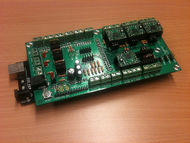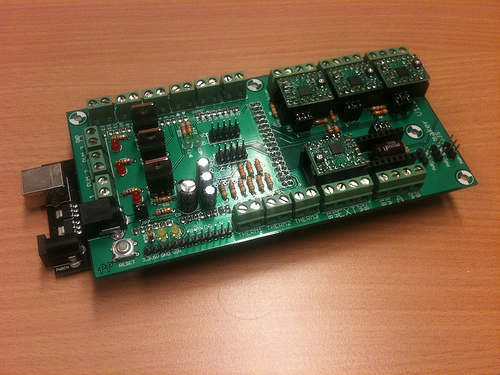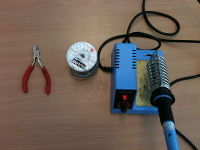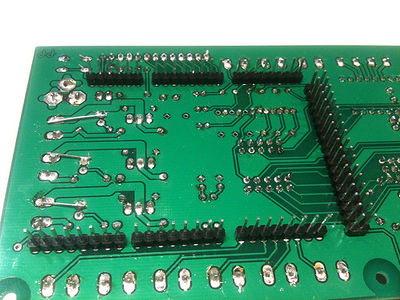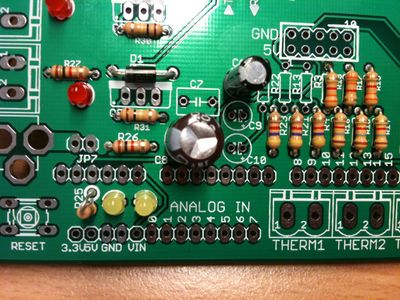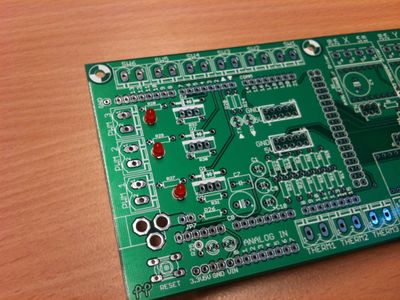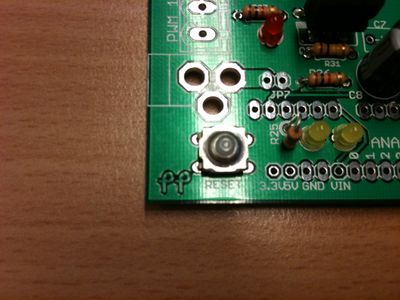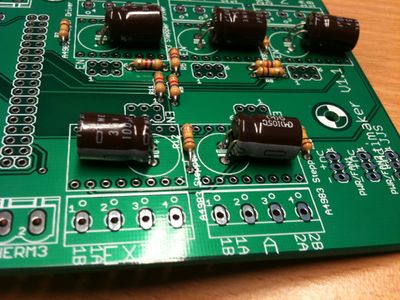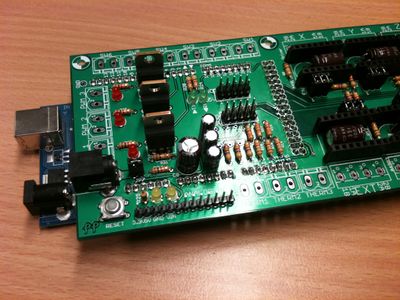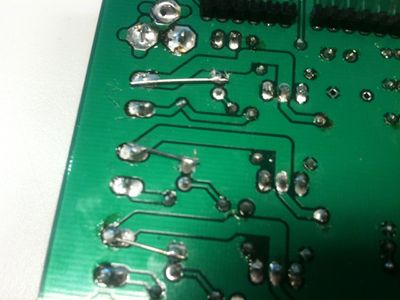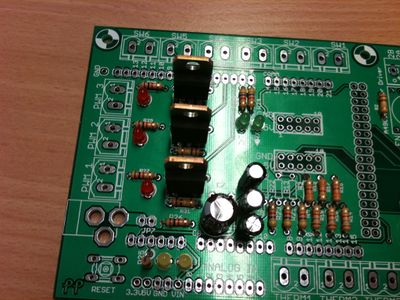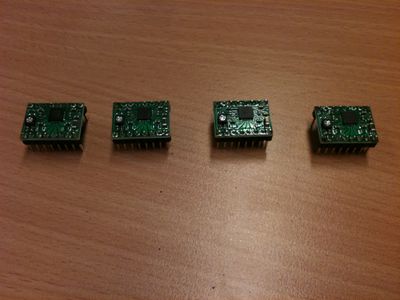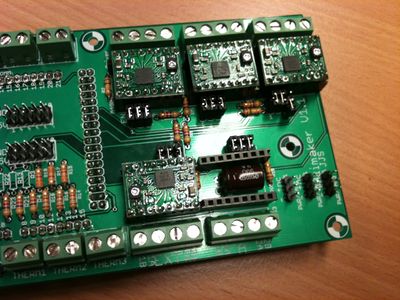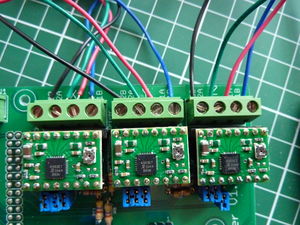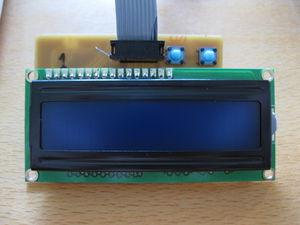Ultimaker's v1.1 PCB
Release status: unknown
| Description | A 5 axis RepRap ArduinoMega Pololu Shield
|
| License | |
| Author | |
| Contributors | |
| Based-on | |
| Categories | |
| CAD Models | |
| External Link |
THIS IS AN OLDER VERSION OF THE PCB
Other versions:
| FILE ID# | TYPE | DESCRIPTION | AVAILABLE FORMATS | CREATED/RESERVED BY |
|---|---|---|---|---|
| Arduino MEGA Ultimaker Shield v1.1.brd (old) | Eagle CAD files | These are Eagle CAD files for the PCB layout | media:Arduino MEGA Ultimaker Shield v1.1.brd | --Erik Mon Nov 29 00:32:06 CET 2010 |
| Arduino_MEGA_Ultimaker_Shield_v1.1.sch (old) | Eagle CAD files | These are Eagle CAD files for the electric circuit | media:Arduino_MEGA_Ultimaker_Shield_v1.1.sch | --Erik Mon Nov 29 00:32:06 CET 2010 |
| Arduino_MEGA_Ultimaker_Shield_v1.1.htm | Parts list | This is a parts list | (couldn't upload .htm... will add it later) | --Erik Mon Nov 29 00:32:06 CET 2010 |
Version 1.1 of the electronics
Warning: this is for version 1.1 of the Ultimaker PCB. If you have a later version of this board, this guide does NOT apply.
This is a board that's very similar to other Pololu-based electronics implementations, including RAMPS, but it can support up to 5 steppers (three for X, Y, Z, one for an extruder and one for any other function). You can add as many steppers as you need. It is designed to run at higher voltages than 12 Volts, This allows you to put 90 Watts out of one MOSFET and run your stepper motors with more torque and higher maximum speeds.
Contents
- 1 THIS IS AN OLDER VERSION OF THE PCB
- 2 Version 1.1 of the electronics
- 2.1 Specifications:
- 2.2 The tools you need
- 2.3 Parts
- 2.4 Step 0 Preparations
- 2.5 Step 1 Arduino pinheads
- 2.6 Step 2 Diodes
- 2.7 Step 3 Resistors
- 2.8 Step 4 Leds
- 2.9 Step 5 Reset button
- 2.10 Step 6 Capacitors (electrolytic Capacitors, mostly called elco's)
- 2.11 Step 8 Male headers/pinheads
- 2.12 Step 9 Female headers/pinheads
- 2.13 Step 10 Wire terminals
- 2.14 Step 11 Wirebridge
- 2.15 Step 12 MOSFETs
- 2.16 Step 13 Stepperboards
- 2.17 Step 14 Place Jumpers
- 3 Wiring it up
- 4 Testing the electronics
- 5 Add-ons
Specifications:
- Arduino Mega Shield
- Compatible with Pololu A4983 stepper drivers
- Controls up to 5 stepper motors.
- 3x 5Amp MOSFETs outputs (with LED indicators)
- All pins are broken out for maximum extensibility
- Runs from 12V to 19V.
- Three thermistor inputs. Designed for 100K thermistor, this one is recommended.
- Has a IDC header for adding an LCD panel (movie here)
The tools you need
- soldering iron
- solder
- wire-snip pliers
- small hacksaw
Parts
On the bill of materials, you'll find a list of all the required components for this main board. You need 3 to 4 hours to solder all of the components onto this board.
TODO: bill of materials!
Bart Bakker - 25oct10 rev.3
Erik de Bruijn - 26 Nov. rev.4 + translation to English
Julius ter Pelkwijk - 03 Dec. rev.4 Full translation to English
Step 0 Preparations
In version 1.1, there's a small mistake, it's not problematic, but it's better to fix it.
The effect of this fault is the fact that the leds next to the mosfets are permantly on, instead of showing that the mosfet is conducting electricity to the PWM exit.
On the left is some place for three leds at R27, 28 and 29.
On the downside of each must be some cutting in the lanes of the island-hole, so that the island becomes a real island.
We did this roughly before offering the boards, but you are advised to check if the island is really free. If needed, follow these instructions to correct the mistake in the v1.1 PCB
Step 1 Arduino pinheads
Check again that this is the version of your board. If not, this one is newer.
We start at the back, the side without any text, with the male pinheads.
This will be the base where the arduino will be sitting later. Carefully break or cut the pinheads to size.
The best way to get the pins well-aligned, is to put these (with the large side) in the Arduino, and then the arduino with the pins still sticking out in the backside of the PCB.
This will make sure that the pins are aligned correctly with the Arduino.
Solder the pins on the front side of the PCB, and remove the Arduino afterwards.
Now we are going to fill the printed side. A well-known method is to start with the smallest components first.
Step 2 Diodes
Oriëntation is IMPORTANT!!!
- 3 diodes D1, D2, D3 - The side with the little stripe points outward from the PCB, not inward.
Step 3 Resistors
The oriëntation of restistors does not matter.
- 10 Resistors of 4K7 (Yellow, Purple, Red) R1, 4, 5, 8, 9, 11, 20, 21, 23, 24
- 8 Resistors of 100K (Brown, Black, Yellow) R2, 6, 7, 10, 12, 30, 31, 32
- 3 Resistors of 3K3 (Orange Orange Red) R15, 17, 19
- 3 Resistors of 1K8 (Brown Grey Red) R14, 16, 18
- 4 Resistors of 1K (Brown Black Red) R26, 27, 28, 29
R3, 13 en 22 stay empty.
Step 4 Leds
Oriëntation is IMPORTANT!!!
PCB seen from above: Flat side (with short legs) facing the bottom (6 o'clock). The lower 2 leds with the flat sides (short legs) towards each other.
This means:
- 3 Red leds on the left side, near R27, 28 and 29. The long legs towards the side of the resistors. The short legs end up in the holes where we cut the tracks from. Dont cut the short legs, we need it at Step 11 for making a wirebridge.
- 2 Yellow leds on the lower left so that the short legs face each other.
- 2 green leds at TX and RX, short leg facing downward.
Step 5 Reset button
- The RESET button in the lower left corner.
- 1 Resistor R25 1K (Brown Black Red) mounted VERTICAL next to the button.
Step 6 Capacitors (electrolytic Capacitors, mostly called elco's)
Oriëntation is IMPORTANT!!!
WARNING: The capacitors are not all aligned logically on the PCB.
Check first for every capacitor before soldering!
- The electrolytical capacitors C1, C9, C10 of 10uF with the white stripe (min) on the left side.
- C8 of 100uF with the white stripe (min) facing towards R26.
On the right side of the board will house 5 daughterboards for the stepper motors.
Under this will house the condensators C2 to C6 of 100uFon their side.
Bend well so that the capacitors are nice flat, else the steppermotor-boards wont fit.
Solder all 5 capacitors with the white stripe (min) facing the outside of the board.
C7 stays empty.
Check now the polarity to ensure that everything is soldered correctly.
If the capacitors are not aligned correctly, they will blow up and cause toxic fumes.
Step 8 Male headers/pinheads
- 2x a double of five long near GND 5V
- 5x a double of three long right center near the letters EN, those are the jumper blocks.
- 3x a single of three long lower right at PWR/FAN
- 1x a single of thirteen long next to the RESET-knop lower left
- 1x single of two long at JP7 lower left
- 1x single of 1 at GND back left at the side. NB: the wooden frame of version 0.9.2 is coming in conflict with this pin, solutions: Cut the pin almost identically straight to the surface, mounted or not, or adapt the wooden frame. The pin is not visible on the picture.
Step 9 Female headers/pinheads
- 10x eight female pinheads on the side of the elco's C2-C6
NB: Cut a row of eight pinheads by sacrificing the ninth one. Cutting between the pinheads is mostly resulting in two unusable pingheads where one is guaranteed one of the counted eight, so you will end up with only seven usable pinheads! This one is unusable because the restmaterial will prevent you from fitting another one next to it.
The cutting goes best if you remove the ninth pinhead first by removing it with a pair of tweezers from the row before cutting (check first the amount before pulling).
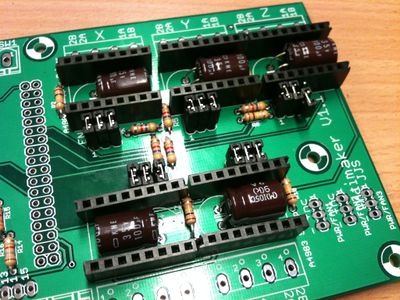
Step 10 Wire terminals
Solder the Wire terminals on the board.
Cut the little pin from the power connector or drill a little hole (due to the power cord strain relief) en solder the connector on the board.
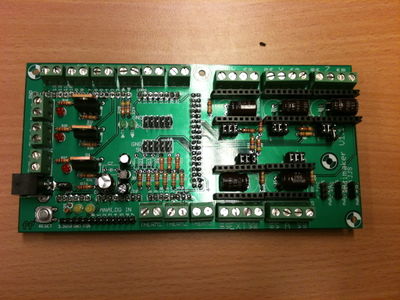
Step 11 Wirebridge
Go to the bottom side, where the connections were cut.
Check if the leg is really free, bend the little leg en solder this leg/wire to each of the three red leds towards the connection with PWM.
Step 12 MOSFETs
Orientation is IMPORTANT!!!
The flat side of the 3 MOSFET transistors must be above the white line.
Add heatsinks on the MOSFET transistors and then the PCB is ready.
Step 13 Stepperboards
WARNING!!!
The stepper boards have really delicate components soldered on them so that there are multiple and pretty easy ways to destroy them, sending them to the electronics graveyard! There are roughly 3 ways to do it:
- Turning the potmeters too quickly (see further), by turning too far en/of using rough tools. Use care and delicacy when handling these potmeters.<BR\>
- Putting the stepperboards the wrong way. This will lead to an electronical explosion and destruction when powered on, also generating sparks. See the picture below for the right oriëntation.
- Wrong connections of a stepper motor. Look for the right connections of the wire: Black-Green-Red-Blue. Changing the order in Blue-Red-Green-Black doesn not damage the stepper board (only turns the way the stepper motor is working). Changing the order between each other will lead to burned stepper boards.
Mounting the stepper boards need to be done the same way as with the Arduino (step 1). Put the stepper boards on the male pinheads. Lay the boards with the component side up, so that you can read 2B, 2A, 1A, 1B next to the side of the crown stem. Put these on the PCB, they will be aligned correctly.
The X, Y and Z are sitting the same, but EXT for the extruder is mirrored.
(A will be staying empty at this moment)
Solder the pinheads on the PCB and then remove the stepperboards.
Screw now the mini potmeters all the way to the left (minimal) and turn them 90 degrees to the right. Do this very CAREFUL!
These potmeters are reducing the power that is going through the steppers.
If they are turned too far right then you will give the chip too much power, thus heating up. If the heat is too much, security will kick in the chip wont work.
You can hear this due to a ticking sound with a frequency of 0.5 seconds.
Now we can put the arduino on the lower side. After placing the jumpers the PCB is ready to be tested.
The endresult will look like the picture above.
Step 14 Place Jumpers
Dont forget to put Jumper 7 between the yellow and red led's. This is a power release. This jumper can be used to connect an on/off switch.
Put for starters with every stepper board a Jumper, exception for the Z-motor (see picture).
The Jumpers that came with the stepper boards have as function to set the (micro)stepsize of the steppermotors.
The stepper motors that are used have 200 steps for one rotation. With the use of microstepping it is possible to get between 2 steps another 16 steps. With the help of jumpers we can adjust if we want this to be full stepping, half stepping, 1/4 stepping, 1/8 stepping or 1/16 stepping.
The smaller the step, the bigger the accuracy, but slower the movement.
The steppers are called 1, 2 and 3. With 1 is the number 1 on the PCB. In the table below is shown how the jumpers can be set:
jumper Yes/No stepsize 1 2 3 no no no full step yes no no half step no no no 1/4 step yes yes no 1/8 step yes yes yes 1/16 step
More information about pololu steppers.
Wiring it up
With the Ultimaker stepper motors you should wire it up like this: Black, green, red, blue.
Testing the electronics
Step 1 Preparation
Remove the stepper boards and the Arduino of the PCB. Power the board with a voltage of between 12 and 20V. There are power inputs on this circuit board, but also on the Arduino Mega, make sure you power this board, the other board will receive its power via USB.
Step 2 PCB
When you turn on the power of this Mega shield, a little LED should be lit now. A common mistake: Jumper 7 is not place (see step 14) or there is a short circuit during soldering.
Step 3 Arduino
Proceed if the LED lights up. Turn of the power and put the shield onto the Arduino Mega. Re-connect the power. If everything goes well then the yellow LED should burn again.
(TESTING ARDUINO SOFTWARE)
Step 4 Stepperboards
Turn the power off and add the stepper boards on the PCB. Watch out for the orientation (see step 13)! The top side of the board should always face outward... the bottom side should alight with the jumpers (that are used to set micro stepping). If everything goes well there should be a yellow led burning. If you want to be extra safe, you could decide to add them one-by-one.
The PCB is now ready to be mounted to the bottom of the Ultimaker or to your RepRap, Mantis or other machine. Also connect the motors and microswitches to the screw terminals.
